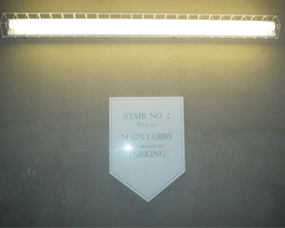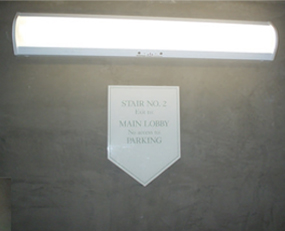Lamar LED Case Study:
Hospitality Construction: Stairwell lighting & Efficiencies in hawaii
Until recently, stairwell lighting wasn’t looked at as an energy conservation measure by energy services companies and facilities managers alike.
Brian Kealoha—SVP, Energy Industries
Hospitality Construction | Energy Industries | energy-industries.com
Energy Savings Opportunity
Better light & safety in Hospitality: an exciting opportunity.
When looking at energy efficiency opportunities in hospitality, one of the first measures evaluated is lighting. Common lighting opportunities have been T-12 to T-8 linear fluorescent lighting retrofits in back-of-house applications, compact fluorescents in guestrooms and downlight cans, and some hotels have adopted cold cathodelamps for their ballroom lighting.
Until recently, stairwell lighting wasn’t looked at as an energy conservation measure by energy services companies and facilities managers alike. Stairwells never really represented a significant opportunity since the lights have to be on 24 hours a day, seven days a week. Typically the solution for these types of areas would be a simple T12 to T8 retrofit. Occupancy sensors that would completely shut off the lights when the space was empty were not a consideration, as this would violate safety and fire codes, and therefore, stairwell lighting was bypassed when evaluating energy savings opportunities.


The solution to this unique application is bi-level lighting, which maintains minimum illumination requirements when the stairwells are empty, thereby maximizing energy savings. Bi-level lighting fixtures have an ultrasonic sensor integrated into the fixture that dims the lighting down to minimum standards when no one is present, dimming the lights to as low as 10 percent of normal output. When the fixture detects someone in the area, the lighting is restored to full brightness. This results in a 50 to 80 percent energy savings per fixture replaced, and most occupants don’t even realize that the lights are motion sensor controlled or that the light levels have changed.
The significance of the savings potential coupled with high energy costs in Hawaii made this an attractive market for bi-level lighting. Six installations were analyzed to determine savings potential. These installations consisted of two high-rise office buildings, three hotels and one hospital. In most of these installations, the standby light levels were reduced to 10 percent in non-occupied mode to maximize the savings.
One installation at a hotel on Waikiki Beach that combined this technology with other energy conservation measures was awarded the Energy Star building label.
The stairwells in the hotel proved to be the least occupied, averaging between 1 to 3 percent. This varied based on the number of floors at the hotel as well as what floor was being monitored. Lower floors of the hotel had slightly more occupancy than the higher floors. The most significant savings were realized in one of the hotel applications where existing two-lamp, 40-watt, T12 lamps and magnetic ballasts were replaced with a two-lamp, bi-level fixture containing two-lamp T8s. With 50 fixtures replaced, this amounted to an annual energy reduction of around 37,000 kwh for an annual energy savings of just over $5,000 or about $100 per fixture. This represents a 78 percent savings from the installation of the bi-level lighting fixtures.
As seen by this data, the hospitality market is a prime candidate for this technology. Since stairwells are seldom used by guests, this technology doesn’t affect the guest experience, especially since the fixtures return to full brightness when the space is occupied.
In addition to the significant energy savings realized from the implementation of bi-level lighting, the project qualified for rebates from the local utility. These projects were installed prior to the passing of the Energy Policy Act of 2005, which now allows for a tax deduction on these installations. Since these are bi-level fixtures, the toughest hurdle for receiving the deduction is cleared. The six installations would have met the watts-per-square-foot reduction for a partial deduction of $.60 per square foot. One installation at a hotel on Waikiki Beach that combined this technology with other energy conservation measures was awarded the Energy Star building label.
Conclusion
Given the success of the technology and Hawaii’s high energy costs, bi-level lighting will soon become the standard fixture for hotels and condominiums. Tax deductions and increasing energy costs also makes this technology appealing for all stairwell applications across the country. There are very few energy conservation measures that offer between a 50 to 80 percent reduction in energy usage, which makes bi-level lighting an exciting opportunity.
By including the battery backup in these fixtures, it also ensures that the emergency lighting will be available if there is a power outage even if the fixtures are not on an emergency circuit. After the October 2006 earthquakes in Hawaii, many hotels quickly discovered that some of the stairwell lighting was not on emergency circuits as previously believed. Hotel employees used glow sticks to help guests through the stairwells while the elevators were not operable during the power outage. The battery backup feature has increased the interest in these bi-level fixtures, as it is now not only providing energy savings but also curing health and safety issues.
Brian Kealoha is senior vice president of Energy Industries, a Hawaii-based energy services company.